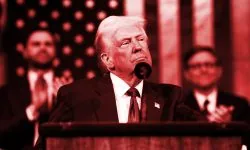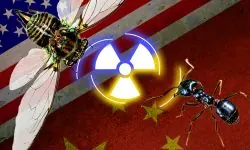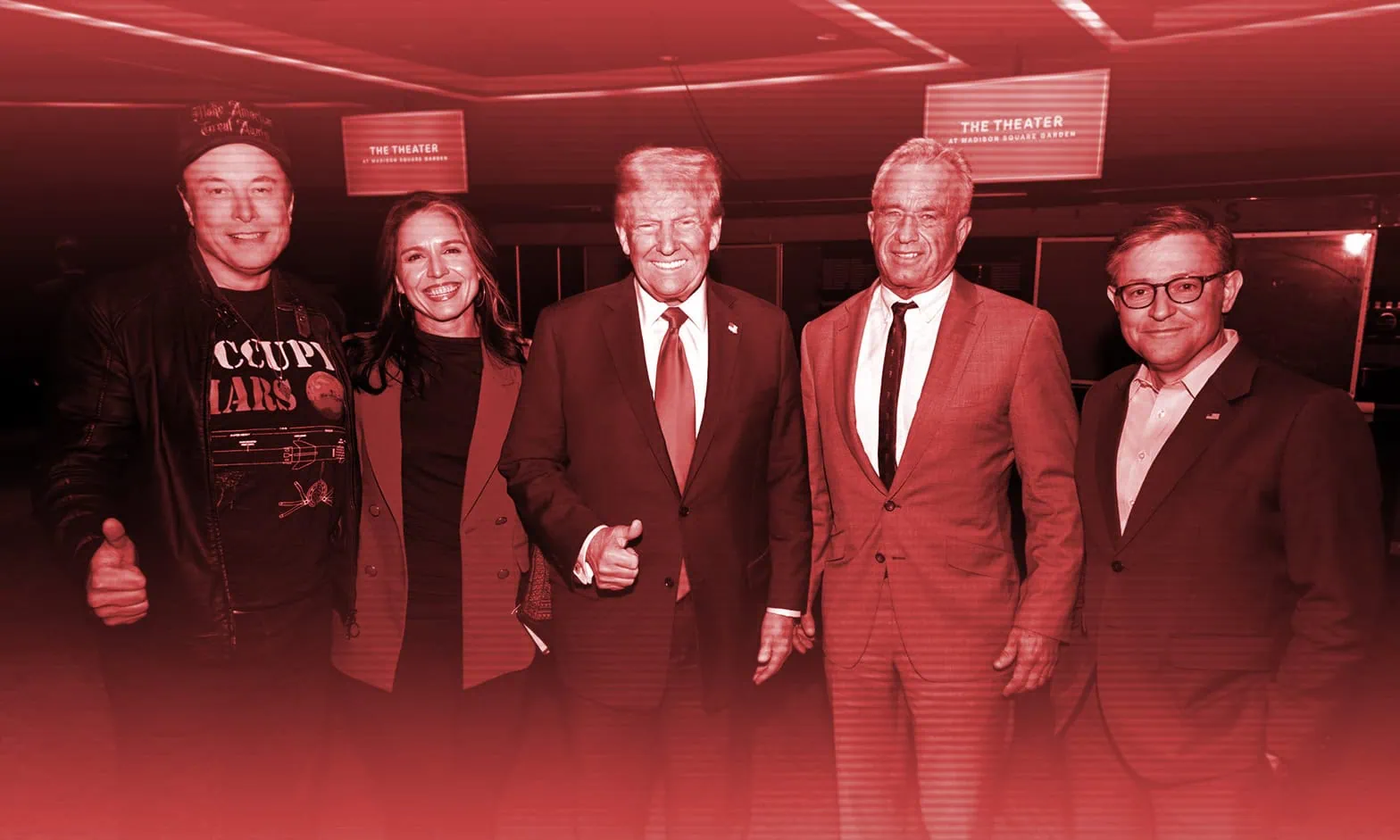(唐纳德-特朗普与埃隆-马斯克、图尔西
加巴德、小肯尼迪和迈克-约翰逊
图片来源:议长办公室
迈克-约翰逊 - 公共领域 )
美国当选总统唐纳德-特朗普宣布加拿大应成为美利坚合众国的 "第 51 个州"。他还经常重复美国应该 "购买格陵兰岛"(亚历山德拉-夏普,"T51ǞǞǞ 美国国旗上的星星?", 外交政策2024 年 12 月 19 日,以及 Anthony Slodkowski 和 James Pomfret,"特朗普申请格陵兰岛引发中国关于如何处理台湾问题的争论", 路透社,2025 年 1 月 15 日)。
与此同时,身家数十亿美元的技术工业家、唐纳德-特朗普的顾问埃隆-马斯克通过 Twitter/X 与辞职的加拿大总理贾斯汀-特鲁多进行了一场激烈的争论。(Anushree Jonko,"马斯克嘲笑贾斯汀-特鲁多关于加美合并的想法,称 "女孩..."", NDTV,2025 年 1 月 8 日。
- 特朗普地缘政治(2)--美国与中国的地缘经济战争

- 战争中的人工智能(4):中美无人机和机器人竞赛

- 如何利用人工智能处理微弱信号--特朗普,国际革命者?

- 突尼斯 ESFSI 早期预警系统和指标高级培训第五年第 2 次会议

- DeepSeek vs Stargate--中国对美国人工智能主导地位的攻势?

- 特朗普地缘政治--1:作为人工智能大国总统的特朗普

- 美国核复兴所需的铀--2:走向全球地缘政治竞赛

这些声明是在总统过渡期间发表的。过渡团队由科技和人工智能领域的高层人士组成。例如,大卫-萨克斯(David Sacks)就是如此,他是科技领域的巨额投资者,也是过渡团队的 "加密货币和人工智能沙皇"("Crypto and AI Czar")。特朗普的硅谷新随从都有谁?",BestofAI,通过 Financialpost.com,2024 年 12 月 19 日)。
人们还必须注意到,副总裁 J. D. Vance 曾是科技商界的风险投资家。其中,他与最有权势的科技亿万富翁之一、Palantir 公司创始人彼得-蒂尔关系密切(艾琳-曼斯菲尔德,"Palantir")。彼得-蒂尔和 JD-万斯Paypal 创始人如何助推副总统候选人的政治生涯", 今日美国2024 年 7 月 17 日)。
这个网络代表了大量的科技和人工智能利益,似乎在当选总统的第一个圈子里非常活跃。他们都主张大幅减少对技术相关事务的监管,这也应涉及到人工智能和加密货币(卡尔-扎克泽姆夫斯基和杰奎琳-阿莱马尼,"人工智能和加密货币")。马斯克并不是唯一一位帮助塑造特朗普政府的科技领袖“, 华盛顿邮报2025 年 1 月 13 日和 Theo Burman,"唐纳德-特朗普的科技 bro 轨道--硅谷如何与 MAGA 合并", 新闻周刊,2025 年 1 月 13 日)。
正如我们将看到的那样,面对这些声明和人工智能界的利益,可以发现特朗普总统政治方针的一些主要驱动因素。
格陵兰和加拿大对国家人工智能产业的发展至关重要。事实上,该行业的飞速发展消耗了越来越多的能源和矿产资源。
因此,从战略角度看,将加拿大作为其外交政策的战略目标是完全合理的("Canada is a strategic target of its foreign policy")。格陵兰的稀土矿化Eurare)。
为了获取制造人工智能计算机所需的稀土元素,格陵兰岛的情况也是如此(另见 Lavoix,"Greenland")。美国核复兴中的铀 (2):走向全球地缘政治竞赛").它还可以减少美国对中国稀土进口的依赖(Nigel Inkster、 大脱钩:中国、美国与科技霸权之争Hurst, 2021)。
因此,我们在此假设,特朗普总统关于加拿大和格陵兰岛的指导方针也是他就任总统之初对美国国家利益的人工智能/战略资源定义的指导方针。
在本文中,我们将探讨 "特朗普二世 "总统对人工智能发展的兴趣如何植根于硅谷的权力网络以及人工智能领域的发展动态。然后,我们强调,有关加拿大和格陵兰的声明揭示了人工智能部门对能源和矿产资源日益增长的兴趣。最后,我们将探讨这些演变在地缘政治和战略方面对美国 "人工智能大国 "的意义。
唐纳德-特朗普二世与人工智能
我们是家庭
唐纳德-特朗普的第二次总统竞选似乎得到了包括人工智能在内的部分科技行业及其一些主要人物的大力支持。其中,彼得-蒂尔的网络似乎相当突出。
彼得-蒂尔是贝宝公司(PayPal)和埃隆-马斯克(Elon Musk)的共同创始人。他还与亚历克斯-卡普(Alex Karp)一起创办了 Palantir,同时受益于中情局创办的风险投资公司 In-Q-Tel 的支持("中情局支持的帕兰提尔技术公司融资 $107.8 百万美元", 路透社S, 2013 年 12 月 11 日,Sharon Weinberger,"大数据领域最可怕、最神秘的独角兽公司 Palantir 即将上市。但它的水晶球只是烟雾和镜子吗?", 纽约杂志2020年9月28日,肖莎娜-祖博夫(Shoshana Zuboff)、 监控资本主义时代,在权力新疆域为人类未来而战伦敦,Profile Books,2019 年和肯尼斯-佩恩、 我,战争机器人,人工智能冲突的曙光伦敦,赫斯特,2021 年)。
马克-安德烈森(Marc Andreesssen)是网络中的另一位重要人物。他是科技和人工智能公司的主要投资者,例如 AirBnB、FaceBook 或 Coinbase 等。马克-安德烈森似乎是特朗普政府的积极招募者(Sarah Mac Bride, "以下是加入特朗普硅谷新班底的科技领袖名单",来自 彭博社, 商业标准》、 2024 年 12 月 20 日)。
如果说微软、Facebook 和亚马逊在总统竞选的主要阶段没有对唐纳德-特朗普发声,那么一些动向似乎值得注意。
例如,亚马逊创始人、身价数十亿美元的杰夫-贝索斯(Jeff Bezos)和历来倾向于民主党的《华盛顿邮报》的所有者下令不为任何候选人背书(Adas Gold 和 Brian Stelter,"《华盛顿邮报》")。贝索斯做出决定后,《华盛顿邮报》不会为 2024 年总统大选的总统候选人背书“, 有线电视新闻网2024年10月25日)。此举是这一主要出口的历史性分岔。
大选结束后,12 月 13 日,制作 GPT 聊天系统的 OpenAI 公司首席执行官萨姆-奥特曼(Sam Altman)宣布:"特朗普总统将带领我们的国家进入人工智能时代,我非常愿意支持他的努力,以确保美国保持领先地位"(" ")。萨姆-奥特曼称特朗普 "将带领我们的国家进入人工智能时代",并向就职典礼基金捐赠 $1 百万美元", 财富通过 美联社2024年12月13日)。随后,他还与马克-扎克伯格和杰夫-贝索斯一起,向唐纳德-特朗普就职日基金捐赠了一百万美元。(朱莉安娜-金、鲍比-阿林"科技大亨奥特曼、扎克伯格和贝索斯为特朗普就职日基金捐款", NPR2024 年 12 月 13 日)。 在科技/人工智能公司中,Adobe、Alphabet Google、Robinhood 和 Uber 也是如此("......")。美国企业承诺为特朗普就职典礼捐款", 路透社,2025 年 1 月)。
现在,这个科技网络的一些成员将成为特朗普政府的一部分。例如,彼得-蒂尔(Peter Thiel)和埃隆-马斯克(Elon Musk)在 Paypal 的前雇员大卫-萨克斯(David Sacks)将成为白宫的 "人工智能和加密货币沙皇"。特雷-斯蒂芬斯(Trae Stephens)是"创始人基金由彼得-蒂尔(Peter Thiel)创建的包括人工智能在内的技术投资基金"...... "可能会成为国防部副部长。
迈克尔-克拉齐奥斯(Michael Kratsios)是彼得-蒂尔在 "创始人基金 "的前参谋长,他在总统过渡期间领导着科技委员会(斯塔夫罗兰-帕布斯特,"泰尔的朋友和风险投资家关注 2和 在五角大楼的职位", 负责任的治国之道2024 年 11 月 27 日;亚当-海斯,"贝宝黑手党将如何主宰新政府", 投资百科2024 年 12 月 23 日。
此外,还有彼得-蒂尔风险基金(Peter Thiel venture fund)之间的密集关系网,除其他外,该基金还投资于埃隆-马斯克(Elon Musk)的公司,如 "新太空 "公司 Space X 以及 Starlink 卫星星座。创始人基金还投资了 Palantir 公司和 Anduril 公司,后者是一家专门生产战斗无人机的公司。硅谷的科幻情结:托尔金、钢铁侠和 PayPal 创始人如何塑造国防人工智能的未来“, 中型、 2024 年 11 月 10 日)。
事实上,这些人以及将他们联系在一起的个人、企业、机构、政治和金融网络实际上代表了美国科技和人工智能产业的广大领域。值得注意的是,Palantir、Anduril、Starlink 等大公司也是人工智能军事化的推动者(Roberto J. Gonzalez、 虚拟战争,冲突自动化、数据军事化和预测未来的探索奥克兰,加州大学出版社,2022 年)。
可以说,埃隆-马斯克在唐纳德-特朗普身边无处不在,体现了人工智能产业日益增长的利益与美国国家利益之间的相互依存关系。事实上,埃隆-马斯克是连接硅谷科技亿万富翁及其产业的多重网络的一部分。
这些网络还将这些人和行业与美国国家安全和国防部门联系在一起(让-米歇尔-瓦朗坦,"美国国家安全和国防")。战争中的人工智能 (1) - 乌克兰", The Red Team Analysis Society2024年4月3日)。由于军事部门是国家的核心组成部分,大赦国际的军事化也成为其机构整合的主要动力(伊恩-莫里斯:《大赦国际的军事化》)、 战争,它有什么好处?从灵长类到机器人的冲突与文明进步Farrar, Strauss and Giroux, 2014)。
因此,从网络分析的角度来看,这些公司实际上是连接人工智能产业和军事部门的节点。它们是实现美国国家利益的工业、战略和行动的驱动力。
国家 A.利益
正如 Helene Lavoix 解释的那样,"美国国家利益 "很简单。从根本上说,它就是保护美国人民的安全(ISSG)。正如 NDS 22 情况介绍所解释的那样,它被进一步细分为三个重要的美国国家利益:
"对美国人民的保护。
NDS 22 概况介绍"(Hélène Lavoix,"美国的国家利益", The Red Team Analysis Society,2022年6月22日)。
美国繁荣的扩张。
实现和捍卫我们的民主价值"。
如今,清单中的第一项和第二项似乎与人工智能领域的发展密切相关。
增长
事实上,根据 Statista 市场预测,美国的人工智能行业正呈现爆炸式增长。其总规模在 2020 年为 256.5 亿美元。2021 年为 548.7 亿美元,2022 年为 346.7 亿美元,这一年是调整年。2023 年达到 372.3 亿美元,2024 年达到 501.7 亿美元。2025 年,美国人工智能行业的增长将达到 662.1 亿美元。如果该行业保持这样的增长速度,2030 年将达到 2236.1 亿美元("人工智能 - 美国", 统计局).
因此,根据 Statista 的数据,这一增长率相当于 2022 年美国 GDP 的 1.22%,2023 年为 1.51%,2024 年为 3.23%。2025 年可能达到 5.13%。按照这个速度,在一切条件不变的情况下,到 2030 年,美国人工智能部门的产值可能相当于美国 GDP 的 14.19%。
这一增长与美国用户数量的增加相辅相成。2020 年为 4813 万,2021 年为 5972 万,2022 年为 75.07 万,2023 年为 92.78 万,2024 年为 112.60 万。假设到 2025 年,美国人工智能用户数量可能达到 1.38 亿。2030 年,在 3.5 亿总人口中,可能达到 2.415 亿人。Statista、 同上)。
半导体中的猛犸象
这种爆炸式的增长速度刺激了对半导体的强烈需求。这种需求推动了 Nvidia 公司的转型。该公司是美国主要的半导体生产商,并在 2024 年成为美国最有价值的两家公司之一。
到 2024 年底,Nvidia 的市值将达到 3.2 万亿美元,而苹果为 3.7 万亿美元,微软为 3.1 万亿美元。对 GPU 芯片的需求如此强劲,以至于 Nvidia 的同比增长达到 2 万亿美元。("英伟达市值在 2024 年因人工智能大涨而提升两万亿美元", 路透社,2025 年 1 月 2 日;Britney Nguyen,"Nvidia 近一半的收入来自 4 家客户。它们是", 石英2024 年 9 月 23 日。
换句话说,美国的人工智能行业正在成为一个强大的经济引擎。其增长节奏是由人工智能技术的特殊性所驱动的。事实上,这些技术整合了从农业、交通到机器人、管理、安全、国际影响和战争等各个领域(埃莱娜-拉沃瓦,"人工智能的未来")。 智慧农业、国际力量与国家利益", The Red Team Analysis Society2019年4月11日和Hélène Lavoix,"用人工智能探索连带影响", Red Team Analysis Society。 2023年5月17日和"通往人工智能的门户-了解人工智能和预见人工智能驱动的世界", Red Team Analysis Society) .
由此看来,人工智能部门对唐纳德-特朗普的支持也代表了对其政府政策方针的支持。
从格陵兰和加拿大到美国人工智能
在这种情况下,特朗普总统对加拿大和格陵兰的兴趣似乎与美国人工智能产业在发电和矿产资源方面的需求密切相关。
事实上,人工智能应用的快速增长及其规模对美国的发电能力造成了巨大压力。
能量差距
据高盛公司称,数据中心对电力的需求保持稳定。在全球范围内,这些基础设施的耗电量占总耗电量的 1% 到 2%。然而,到 2030 年,这一需求将增长 160%。这一激增与人工智能的发展有着内在联系。事实上,如果谷歌搜索每小时消耗 O.3 瓦特,那么单个 Chat GPT 请求就会消耗 2.9 瓦特/小时的电力("......")。GS Sustain:世代增长:人工智能、数据中心和即将到来的美国电力激增", 高盛集团2024 年 4 月 29 日)。
根据高盛集团(Goldman Sachs)的数据,数据中心已经消耗了美国 3% 的发电量。然而,到 2030 年,这一需求可能会增长到 8%。为了满足这一需求,美国将需要增加 47 千兆瓦的发电能力。因此,正如埃莱娜-拉沃瓦(Hélène Lavoix)所说,"美国核复兴 "项目(埃莱娜-拉沃瓦,"迈向美国核复兴?" The Red Team Analysis Society2024 年 10 月 15 日)。
这种增长速度使得亚马逊、OpenAI-微软、谷歌等人工智能行业都表示希望获得自己的核反应堆(Darrell Proctor," ")。微软将重启三里岛核电站为人工智能提供动力", 电源2024 年 9 月 20 日,Brian Martucci,"在微软 PPA 的推动下,Constellation 计划于 2028 年重启三里岛 1 号机组", 实用潜水2024 年 9 月 20 日,Darrell Proctor,"AWS 收购核能驱动的数据中心园区", 电源,2024 年 3 月 4 日;Helene Lavoix,"迈向美国核复兴?“, The Red Team Analysis Society).
这些能源需求与人工智能的使用需求相辅相成。人工智能的发展破坏了美国电力市场的稳定,从而导致了 "核复兴 "的需要(拉沃瓦,同上)。因此,美国理论上有兴趣更好地利用加拿大的铀矿、石油、天然气和水力发电(Helene Lavoix,"核复兴")。美国核复兴中的铀 (2):走向全球地缘政治竞赛", The Red Team Analysis Society 2025 年 1 月 18 日)。
在此背景下,特朗普总统对加拿大的兴趣似乎源于美国的人工智能增长/电力需求/发电等式。事实上,通过水力发电、阿尔伯塔省的页岩油气生产、可再生能源及其铀矿,加拿大是能源生产大国(埃莱娜-拉沃瓦,"加拿大的能源")。美国核复兴所需的铀- 1:满足前所未有的要求", The Red Team Analysis Society2024 年 11 月 27 日,以及 Ian Riach,"人工智能数据中心渴求电力,加拿大正在响应号召", 加拿大信托基金2024 年 11 月 18 日)。
埃里克-施密特案例
将人工智能产业的新兴能源需求转化为政治话语的形式多种多样。例如,值得引用谷歌联合创始人埃里克-施密特(Eric Schmidt)的话。在斯坦福大学的一次会议上,他宣称
"我去了趟白宫,告诉他们我们必须成为加拿大最好的朋友,....。因为他们有......大量的水电,而我们(美国)没有足够的电力......所以,替代方案是阿拉伯人......但他们不会遵守我们的国家安全规则......而美国和加拿大是一个巨大大陆的一部分......"。
埃里克-施密特,"一秒不删--谷歌前首席执行官施密特应邀发表演讲(秘密会议)。
碰巧的是,埃里克-施密特有可能进入白宫,因为从 2018 年(特朗普首次担任总统期间)到 2021 年(乔-拜登担任总统期间),他一直是美国国家科学院的主席。 国家人工智能安全委员会.他以这一身份在人工智能部门与联邦国家、国家安全界和美国民间社会的共同融合领域发出了响亮的声音。我们必须注意到,该委员会的主要建议之一是 "美国政府必须接受人工智能竞争,并组织起来赢得竞争"。
因此,似乎可以将特朗普总统关于加拿大成为美国联邦 "第51个州 "的声明解释为加拿大对美国人工智能产业和力量发展的战略重要性的 "官方翻译"。这也体现了人工智能行业对获取足够能源以支持其发展的日益关注。
一个(非常)物质化的人工智能世界
美国人工智能部门对材料的需求不仅限于能源。这一工业部门需要大量稀土矿物。要生产人工智能计算机所需的半导体,这些元素必不可少。然而,这些矿物的主要矿山和提炼能力都是在中国开发的。这种情况造成了需要稀土元素及其提炼的国家和公司与中国之间事实上的依赖关系(Inkster,同上)。
这些矿物是半导体生产的基本需求。因此,举例来说,它们对 Nvidia 公司至关重要。碰巧的是,中国政府目前正在禁止向美国出口稀土元素和稀土加工技术。
此举是对美国贸易战和对华技术禁令的报复,自 2018 年特朗普总统发动贸易战以来,贸易战和技术禁令不断升级(Gracelin Baskaran, " 美国对华贸易战和技术禁令")。中国禁止稀土加工技术意味着什么?", CSIS2024 年 1 月 8 日,以及爱德华多-巴普蒂斯塔,"在中国禁止矿产出口之后,它还能如何应对美国芯片的遏制?", 路透社2024年12月3日)。因此,这一禁令危及美国人工智能的发展,以及美国的国家利益和安全。
在此背景下,当当选总统特朗普表示有意 "购买格陵兰岛 "时,值得注意的是,格陵兰岛蕴藏着不同稀土元素的重要矿藏"世界为何转向格陵兰稀土金属?", 创新新闻网创新新闻网,2023 年 8 月 3 日)。
事实上,格陵兰属于欧洲-丹麦法律管辖范围。不过,自 1941 年以来,格陵兰就是美国防务范围的一部分。事实上,格陵兰岛是空军/太空部队皮图弗里克基地(又称 "图勒基地")的所在地。
因此,在人工智能时代,稀土元素矿藏有力地提升了格陵兰对美国的战略价值。特朗普总统的声明正是将这一动态转化为政治指导方针的方式。
美国人工智能力量主席
换句话说,在唐纳德-特朗普总统的第二个任期内,人工智能领域极有可能与美国作为 21 世纪大国的地位实现战略融合。
迈向人工智能国家
随着 "政府效率部"(DOGE)的成立,这种态势已经以制度化的方式表现出来。这个由埃隆-马斯克(Elon Musk)担任主席、维维克-拉马斯瓦米(Vivek Ramaswamy)担任联合主席的总统咨询委员会将推动技术发展,以此减少联邦机构和雇员的数量。
该委员会的主要任务是领导 "三大类改革:监管撤销、行政削减和成本节约"。委员会的部分目标是在快速变化的数字和技术背景下重新定义政府效率(Ross Gianfortune,"政府效率")。拟议的性别平等办公室改革以技术和效率为目标"。, GOVCIO 媒体研究, 01/06/2025).
换句话说,DOGE 将(努力)引导当前技术(即人工智能)与联邦国家的融合,同时减少对技术领域的监管(Ross Gianfortune,同上)。恰好,这些目标与埃里克-施密特(Eric Schmidt)担任主席的国家人工智能安全委员会(National Security Commission on AI)提出的建议非常一致(施密特,同上,见上文)。
这有力地表明,2021 年公布成果的委员会的工作与 2024-2025 年性别平等办公室的计划之间存在连续性。这种连续性尤其体现在委员会 2021 年目标的共享上,该目标阐明了人工智能部门在政府机构和美国社会结构中的预测需求,以及性别平等办公室宣布的任务,这似乎是这些目标的实际转化。
走向人工智能地缘政治升级?
我们必须记住,这些目标是在人工智能迅速军事化和武器化的背景下实现的。这一动态的驱动力之一是美国对技术的军事需求。另一个驱动因素是与另一个大国中国的竞争。中国也在引领其军事力量的快速 "智能化"(Jean-Michel Valantin,"中国的人工智能")。战争中的人工智能 (2) - 为中美战争做准备 ?", The Red Team Analysis Society2024 年 9 月 17 日)。
因此,特朗普的第二任总统任期很可能会被视为产生美国形式的人工智能政治权力和治理的政治结构。这可能会通过将人工智能革命引入联邦政府的运作来实现
这种人工智能渠道已经在将美国定义为大国地缘政治准则的过程中打下了烙印。因此,这种动态可能成为海伦-拉沃瓦(Helene Lavoix)所定义的 "人工智能世界中的人工智能力量 "的美国政治版本("人工智能何时为地缘政治提供动力 - 呈现AI", The Red Team Analysis Society, 2017年11月27日)。
现在,我们必须看到美国的人工智能力量将如何与其盟友和敌人互动。



感谢作者;这篇文章似乎是将特朗普的政策与技术进步联系起来的深入分析。